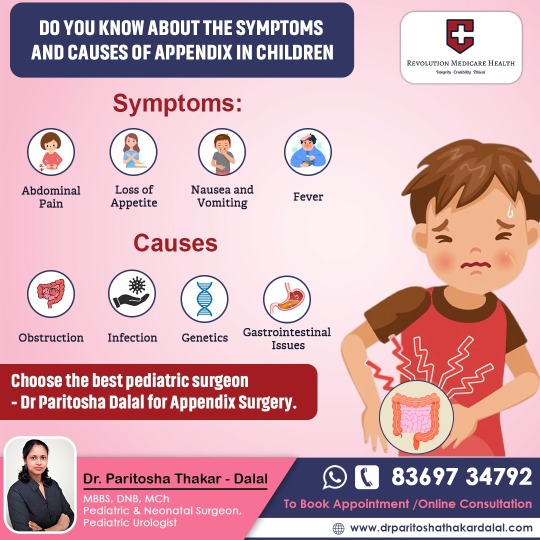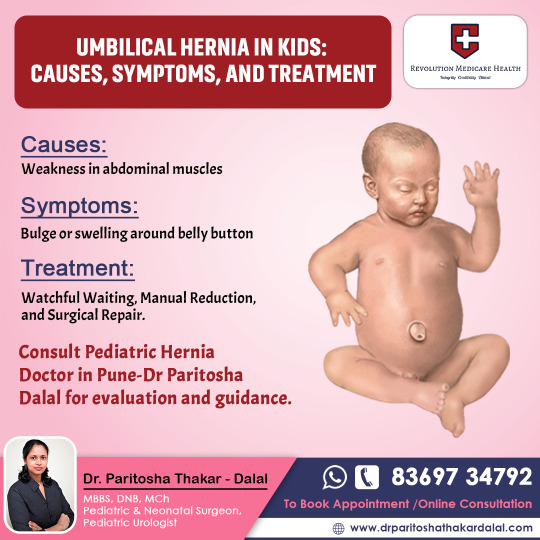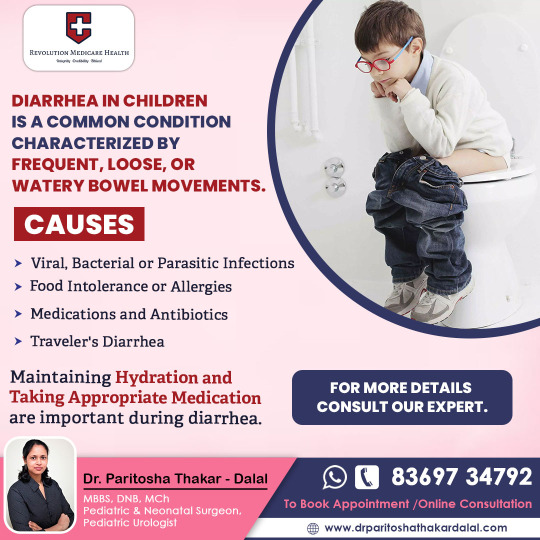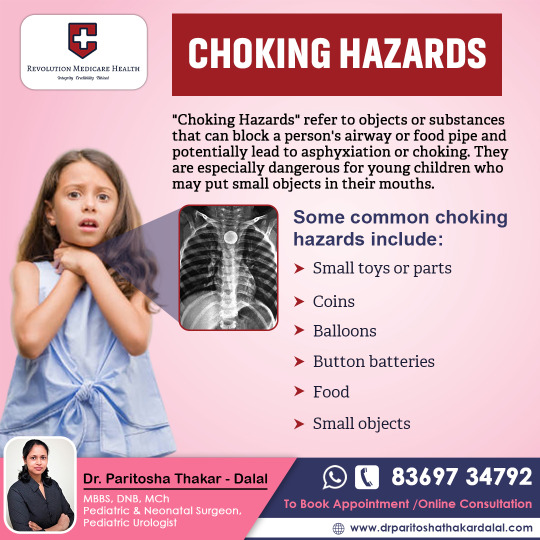Don't wanna be here? Send us removal request.
Text

🩺 Vesicoureteral Reflux (VUR) – Know the Signs! 🚨
VUR occurs when urine flows backward from the bladder to the kidneys, increasing infection risks. 🦠🚰
🔴 Signs to watch for: ✅ Frequent urinary infections 🔄 ✅ Pain while urinating 😣 ✅ Fever without a clear reason 🌡️ ✅ Weak urine flow ��
👶 Early diagnosis can prevent complications! If your child has recurring UTIs, consult Dr. Paritosha Thakar-Dalal, a Pediatric & Neonatal Surgeon 🏥💙.
📞 Book an appointment today! ☎️ 83697 34792 🌐 Visit: www.drparitoshathakardalal.com
0 notes
Text

Symptoms and Causes of Appendix in Children
#.#DrParitoshaDalal#PediatricSurgeon#bestpediatricsurgeoninindia#appendixsurgery#pediatricsurgeon#appendixdoctor#symptoms#causes#appendixinchildren#Pune
0 notes
Text

Best Appendix Surgery in Pune- Dr Paritosha Dalal
#DrParitoshaDalal#PediatricSurgeon#bestpediatricsurgeon#PediatricCare#PediatricSurgery#ChildSurgery#ChildrensSurgery#SurgicalTreatment#Treatments#pune#appendixsurgery#appendixinchildren#appendixdoctor#pediatricappendixsurgeon#stomachache
0 notes
Text
Understanding Umbilical Hernias in Infants and Children: Causes, Symptoms, and Treatment

Umbilical hernias are a common occurrence in infants and children, characterized by a protrusion of abdominal contents through a weakened area around the belly button (umbilicus). In this article, we will delve into the causes, symptoms, and available treatments for umbilical hernias in young ones.
Causes of Umbilical Hernias:
Umbilical hernias develop when there is a weakness in the muscles around the umbilicus, allowing a portion of the abdominal contents, such as fat or part of the intestine, to push through the weakened area. This can result from a variety of factors, including:
Incomplete Muscle Closure: In infants, the abdominal muscles around the umbilicus might not completely close at birth, leaving a small opening through which a hernia can develop.
Premature Birth: Premature infants are more likely to have underdeveloped abdominal muscles, which can contribute to the formation of umbilical hernias.
Genetic Predisposition: A family history of umbilical hernias might increase the likelihood of a child developing one.
Symptoms of Umbilical Hernias:
The primary symptom of an umbilical hernia is a noticeable bulge or swelling in the belly button area. This bulge can vary in size, and it becomes more evident when the child cries or strains. In many cases, umbilical hernias are painless and don't cause any discomfort. However, complications can arise if the hernia becomes incarcerated or trapped, leading to symptoms such as:
Pain and Tenderness: An incarcerated hernia can cause pain and tenderness around the hernia site.
Swelling: The hernia might become swollen and more prominent.
Nausea and Vomiting: In more severe cases, an incarcerated hernia can lead to nausea and vomiting.
Treatment Options for Umbilical Hernias:
The management of umbilical hernias depends on factors such as the size of the hernia, the child's age, and the presence of symptoms. Treatment options include:
Watchful Waiting: For small umbilical hernias that are asymptomatic, doctors might recommend a wait-and-see approach. Many small hernias tend to close on their own as the child's muscles develop over time.
Manual Reduction: If the hernia becomes trapped or incarcerated, a medical professional can gently push the protruding tissue back into the abdomen. This procedure should only be performed by a healthcare provider.
Surgical Repair: If the umbilical hernia persists or causes significant discomfort, surgery may be recommended. It is important to consult a Pediatric Hernia Doctor in Pune- Dr. Paritosha Dalal if you notice an umbilical hernia in your child.
#umbilicalhernia#pediatricherniadoctor#herniatreatment#pediatricsurgeon#DrParitoshaDalal#herniasurgery
0 notes
Text

Children specialist in Pune- Dr Paritosha Dalal
For More Details Consult Our Expert Dr. Paritosha Thakar-Dalal. Children Specialist in Pune
#DrParitoshaDalal#PediatricSurgeon#bestpediatricsurgeoninindia#Diarrhea#infections#symptoms#causes#complications#PediatricCare#PediatricSurgery#ChildSurgery#ChildrensSurgery#SurgicalTreatment#Treatments#bestdoctorinpune#pune
0 notes
Text
CONCERNED ABOUT YOUR CHILD'S URINE STREAM? GET PROPER EVALUATION FOR POSSIBLE OBSTRUCTION!

What is a Poor Urine Stream?
A "poor urine stream" refers to a weakened or reduced flow of urine during urination. In children, this can be particularly concerning as it may indicate an obstruction in their urinary tract. Potential Causes of Poor Urine Stream: 1. Urinary Tract Infections (UTIs): UTIs are common in children and can cause inflammation that temporarily affects urine flow. 2. Congenital Anomalies: Some children may be born with structural abnormalities in their urinary tract, leading to poor urine stream. 3. Urethral Stricture: Narrowing of the urethra due to scar tissue can hinder the flow of urine. 4. Kidney Stones: Though uncommon in children, kidney stones can obstruct urine flow and cause discomfort. 5. Neurogenic Bladder: Conditions affecting the nerves that control the bladder can lead to problems with urination. Medical Evaluation: If your child is experiencing a poor urine stream, it is essential to consult Pediatric Urologist- Dr Paritosha Dalal promptly. Treatment Options: The treatment will depend on the underlying cause of the poor urine stream. A poor urine stream in children can be a worrying sign of a possible urinary tract obstruction or underlying health condition. If your child is experiencing such issues, do not delay seeking professional medical evaluation Remember, early intervention can make a significant difference in your child's urinary health and overall well-being. Your child's health is a priority, and addressing their urinary concerns promptly can pave the way for a healthier and happier future. Consult Pediatric Urologist in Pune- Dr. Paritosha Dalal as timely intervention can lead to better outcomes and improve your child's overall well-being.
#pediatricurologist#pediatricsurgeon#uti#UrineInfectionInKids#urinarybladder#bladderissues#DrParitoshaDalal#poorurination#urinaryproblems#causes#symptoms#pediatricdoctor#childrenspecialist#pune
0 notes
Text

Choking Hazards in Kids- Children Specialist in Pune
#DrParitoshaDalal#PediatricSurgeon#bestpediatricsurgeoninindia#Chokinghazards#Choking#causes#complications#PediatricCare#PediatricSurgery#ChildSurgery#ChildrensSurgery#SurgicalTreatment#Treatments#bestdoctorinpune#pune
0 notes
Text
Learn about managing bedwetting in children

Bedwetting, or nocturnal enuresis, is a common issue that many children experience. It can be frustrating and embarrassing for both children and their parents. However, it's important to remember that bedwetting is a normal part of a child's development, and there are effective strategies to help manage and overcome it. This post aims to provide a brief overview of bedwetting in children and offer some helpful tips for parents.
Normal Development: Bedwetting is considered normal in young children, particularly those under the age of five. As a child grows, their bladder capacity increases, and they develop better control over their urinary system. Most children outgrow bedwetting on their own, but for some, it may persist beyond the age of five.
Causes of Bedwetting:
There can be several underlying causes of bedwetting, including:
a) Delayed bladder maturation: Some children may have a bladder that takes longer to mature, leading to difficulties in holding urine overnight.
b) Hormonal factors: Antidiuretic hormone (ADH) plays a crucial role in regulating urine production at night. In some children, the production of ADH may be insufficient, leading to increased urine production and bedwetting.
c) Deep sleep patterns: Children who have deep sleep patterns may not respond to the body's signals of a full bladder, resulting in bedwetting.
d) Emotional or psychological factors: Stress, anxiety, or major life changes can contribute to bedwetting in some cases.
Strategies for Managing Bedwetting:
Here are some practical tips to help manage bedwetting:
a) Encourage regular bathroom breaks: Encourage your child to empty their bladder before bedtime and ensure they use the bathroom regularly during the day.
b) Limit fluid intake: Reduce the amount of fluid your child drinks in the evening, particularly before bedtime. However, make sure they stay adequately hydrated throughout the day.
c) Use protective measures: Place a waterproof mattress cover or disposable absorbent underpads on the bed to protect it from moisture. This helps reduce the stress and mess associated with bedwetting incidents.
d) Bedtime routines: Establish a consistent bedtime routine that includes using the bathroom before sleep. This helps train the bladder and sets a pattern for your child's body.
e) Positive reinforcement: Avoid punishment or shaming your child for bedwetting. Instead, offer praise and rewards for dry nights to encourage positive behavior.
f) Seek medical advice if necessary: If bedwetting persists or becomes a cause of distress for your child, consult with Pediatric Urologist- Dr Paritosha Dalal who can provide further guidance and explore potential underlying causes.
Bedwetting is a common issue that many children experience during their development. Remember that patience, understanding, and support are crucial when helping your child manage bedwetting. By implementing these strategies and maintaining a positive approach, you can support your child on their journey towards dry nights and help them overcome bedwetting with confidence.
#pediatricsurgeon#drparitoshadalal#bestdoctorinpune#bestpediatricsurgeoninindia#surgicaltreatment#pune#pediatriccare#treatments#childrenssurgery#pediatricsurgery#urologist
0 notes
Text

Children Specialist in Pune
Preventing playground injuries requires adequate supervision, proper equipment maintenance, and adherence to safety guidelines. Impact-absorbing surfaces, promoting safe play habits, and educating children and parents about risks are important preventive measures. Creating a safe playground environment ensures children can engage in physical activity and play without unnecessary harm.
For More Details Consult Our Expert Dr. Paritosha Thakar-Dalal. Children Specialist in Pune
#DrParitoshaDalal#PediatricSurgeon#bestpediatricsurgeoninindia#Playgroundinjuries#activeandsafe#tipsforkid#avoidinjuries#summerhealthtips#summercare#PediatricCare#PediatricSurgery#ChildSurgery#ChildrensSurgery#SurgicalTreatment#Treatments#bestdoctorinpune#pune
0 notes
Text
https://drparitoshathakardalal.com
Best pediatric surgeon in Pune | Dr. Paritosha Thakar-Dalal | Pediatric Surgery in Pune
Are you searching for Paediatric Surgery in Pune? Dr. Paritosha Thakar-Dalal is the best pediatric surgeon. Book an appointment now for child disease treatment.
#DrParitoshaDalal#PediatricSurgeon#bestpediatricsurgeoninindia#Diarrhea#infections#symptoms#causes#complications#PediatricCare#PediatricSurgery#ChildSurgery#ChildrensSurgery#SurgicalTreatment#Treatments#bestdoctorinpune
0 notes
Text
Understanding Childhood Incontinence

Childhood incontinence is a common but often misunderstood condition that affects many children around the world. It can manifest as bedwetting (nocturnal enuresis) or daytime accidents (diurnal enuresis). While incontinence can be challenging for both children and their parents, it is crucial to approach the issue with understanding, compassion, and support. By exploring the causes, potential treatments, and strategies for managing childhood incontinence, we can empower families to navigate this condition with confidence and positivity.
Normalizing the Conversation: First and foremost, it is important to recognize that childhood incontinence is a common issue that many children experience. Normalizing the conversation around incontinence helps reduce stigma and encourages open communication between parents, children, and healthcare providers. By understanding that incontinence is a medical condition and not a result of laziness or lack of control, we can create an environment where children feel comfortable seeking help and support.
Causes and Contributing Factors: Childhood incontinence can have various underlying causes and contributing factors. It may be the result of a delay in the maturation of the bladder and urinary system, genetics, hormonal imbalances, or emotional stress. Recognizing these factors can help parents and healthcare professionals identify potential triggers and develop appropriate management strategies. In some cases, addressing underlying medical conditions such as urinary tract infections or constipation can also alleviate incontinence symptoms.
Treatment Options and Strategies: There are several treatment options available to manage childhood incontinence effectively. Behavioral interventions, including fluid management, timed voiding, and pelvic floor exercises, can help improve bladder control. Bedwetting alarms can be useful for nocturnal enuresis, helping children wake up when they need to urinate. In some cases, medication may be prescribed to address specific underlying causes or provide temporary support. It is crucial to work closely with healthcare professionals to determine the most suitable treatment approach for each child.
Emotional Support and Coping Strategies: Living with childhood incontinence can impact a child's emotional well-being and self-esteem. Parents, caregivers, and teachers play a vital role in providing emotional support and fostering a positive environment. Encouraging open discussions, praising progress, and avoiding blame or shame are essential for building a child's confidence. Implementing coping strategies, such as using discreet protection products and involving the child in the management process, can also help them feel empowered and in control of their condition.
Seeking Professional Guidance: Parents should not hesitate to seek professional guidance when dealing with childhood incontinence. Consult Pediatric Urologist or Children Specialist experienced in treating pediatric incontinence can provide valuable insights and guidance tailored to each child's unique needs. They can offer thorough evaluations, diagnose any underlying conditions, and recommend appropriate treatment options. Working together as a team, parents, children, and Children Specialist can navigate childhood incontinence with confidence and optimize the child's quality of life.
Childhood incontinence is a manageable condition that requires understanding, support, and patience. By normalizing the conversation, exploring causes and treatment options, providing emotional support, and seeking professional guidance, families can effectively manage and overcome the challenges associated with childhood incontinence. Remember, each child's journey is unique, and with the right approach, we can empower children to thrive and enjoy a life filled with confidence, understanding, and support.
#DrParitoshaDalal#PediatricSurgeon#bestpediatricsurgeoninindia#Childhoodincontinence#urineincontinence#stoolincontinence#causes#complications#PediatricCare#PediatricSurgery#ChildSurgery#ChildrensSurgery#SurgicalTreatment#Treatments#bestdoctorinpune#pune
0 notes
Text

Best Pediatric Surgeon in Pune
Consult Our Expert Dr. Paritosha Thakar-Dalal.
#DrParitoshaDalal#PediatricSurgeon#bestpediatricsurgeoninindia#review#positivefeedback#happypatients#Googlereview#fivestarreview#PediatricSurgery#ChildSurgery#ChildrensSurgery#SurgicalTreatment#Treatments#bestdoctorinpune#pune
0 notes
Text
Tips for Preventing Playground Injuries

Playground injuries are accidents that occur while children are playing on playground equipment. They can range from minor cuts and bruises to more severe injuries like fractures and concussions. Common causes include falls from equipment, collisions with other children, and entrapment. Preventing playground injuries requires adequate supervision, proper equipment maintenance, and adherence to safety guidelines. Impact-absorbing surfaces, promoting safe play habits, and educating children and parents about risks are important preventive measures. Creating a safe playground environment ensures children can engage in physical activity and play without unnecessary harm. To help prevent playground injuries in children, here are some tips:
Adult supervision: Ensure that children are supervised by a responsible adult while playing on the playground. This helps to prevent accidents and allows for immediate assistance if needed.
Age-appropriate equipment: Make sure the playground equipment is suitable for your child's age and developmental stage. Younger children should have access to equipment designed for their abilities, and older children should have equipment designed to challenge them appropriately.
Safety guidelines: Teach children about playground safety rules, such as not pushing or shoving, waiting for their turn, and using equipment properly. Reinforce the importance of following these guidelines consistently.
Proper clothing: Encourage children to wear appropriate clothing and footwear while playing on the playground. Loose clothing and open-toed shoes may increase the risk of accidents.
Safe surfacing: Choose playgrounds with soft surfaces such as wood chips, sand, or rubber mats beneath the equipment. These surfaces provide cushioning and reduce the risk of severe injuries from falls.
Teach safe behaviour: Educate children about safe behaviour on the playground. Teach them to wait their turn, avoid pushing or shoving, and use equipment as intended. Discourage risky behaviours like climbing on the outside of the equipment or jumping off from heights.
Sun protection: Apply sunscreen to protect children's skin from harmful UV rays, especially during sunny days. Encourage them to wear hats and sunglasses for additional protection.
Stay hydrated: Ensure that children drink enough water to stay hydrated while playing on the playground, especially during hot weather.
First- Aid Knowledge: Having first aid knowledge for children in playgrounds is crucial for immediate response and reducing the severity of injuries. It allows you to provide initial care, comfort, and reassurance to injured children while waiting for medical help. First aid can also help prevent complications and buy time for professional assistance to arrive.
By implementing these safety measures, you can create a safer environment for children to enjoy their time on the playground while minimizing the risk of injuries. It is important to consult a Children Specialist immediately in case of any accident or mishappening.
0 notes
Text

Tips for encouraging good hand hygiene in kids during the summer
Consult Our Expert Dr. Paritosha Thakar-Dalal.
Children Specialist in Pune
#DrParitoshaDalal#PediatricSurgeon#bestpediatricsurgeoninindia#handhygiene#hygienetips#tipsforkid#summerhealthtips#summercare#PediatricCare#PediatricSurgery#ChildSurgery#ChildrensSurgery#SurgicalTreatment#Treatments#bestdoctorinpune#pune
0 notes
Text
Gastrointestinal Disorders in Children: Diagnosis and Treatment

Gastrointestinal disorders in children can lead to significant discomfort and affect their overall well-being. It's important for parents and caregivers to understand the diagnosis and treatment options available for these conditions. In this blog post, we will explore the common gastrointestinal disorders seen in children, their symptoms, and approaches to diagnosis and treatment.
What are Gastrointestinal Disorders?
Gastrointestinal disorders encompass a range of conditions affecting the digestive system in children. Some common disorders include gastroesophageal reflux disease (GERD), irritable bowel syndrome (IBS), celiac disease, and inflammatory bowel disease (IBD). Each disorder has its own set of symptoms and requires a tailored approach to diagnosis and treatment.
Diagnosis of Gastrointestinal Disorders:
Accurate diagnosis is crucial for effective management of gastrointestinal disorders in children. The diagnostic process often involves a comprehensive medical history review, physical examination, and possibly laboratory tests or imaging studies. In some cases, further specialized tests such as endoscopy or colonoscopy may be required. The healthcare provider will consider the child's symptoms, family history, and test results to make a definitive diagnosis.
Common Treatment Approaches:
Treatment strategies for gastrointestinal disorders in children aim to alleviate symptoms, promote healing, and improve overall well-being. The treatment plan may include a combination of lifestyle modifications, dietary changes, medications, and sometimes surgery.
Lifestyle modifications often involve encouraging regular physical activity, managing stress, and promoting a balanced diet. For conditions like GERD or IBS, identifying and avoiding trigger foods or beverages can significantly reduce symptoms.
In certain cases, medication may be prescribed to manage symptoms or address underlying inflammation. For example, proton pump inhibitors or H2 blockers are commonly used to reduce acid reflux in children with GERD. Anti-inflammatory medications and immunosuppressants may be prescribed for children with IBD.
In more severe cases or when conservative measures fail to provide relief, surgical intervention may be necessary. Surgeries for gastrointestinal disorders in children range from minimally invasive procedures to major abdominal surgeries, depending on the specific condition and its severity.
Gastrointestinal disorders in children can have a significant impact on their health and daily life. Early diagnosis and appropriate treatment are essential for managing these conditions effectively. Consult Pediatric Gastroenterologist Surgeon in Pune for overall well-being of children with gastrointestinal disorders.
#pediatricsurgeon#drparitoshadalal#pune#pediatricsurgery#pediatric gastroenterologist in pune#pediatric gastro doctor in pune#pedaitric gastro surgeon in pune#abdominal pain in children#stomach pain in children
0 notes
Text
https://drparitoshathakardalal.com/
#pediatricsurgery#pediatricsurgeon#dr paritosha dalal#pune#pediatric gastroenterologist in pune#pediatric cancer surgeon#pediatric stomach pain doctor
0 notes
Text
Most Common type of Cancer in Children
Cancer is one of the most rapidly rising non-communicable diseases, and it has not spared children. However, the cancers that affect youngsters differ from those that affect adults. Unlike lifestyle or environmental variables, early DNA changes are known to cause childhood cancers.
Every year, more children are diagnosed with cancer. Nearly 50,000–60,000 children in India are thought to have the condition, and there are undoubtedly many more who go undiagnosed or are unable to receive timely treatment. Due to a variety of reasons, the numbers are only anticipated to increase in the upcoming years. Cancer is still an illness that can be effectively controlled or treated if detected early, just like for adults.
Are cancers in children curable?
Even though they are frightening, childhood malignancies are very treatable if detected early and correctly. Nearly 80% of pediatric malignancies are treatable. If cases are caught early, children can enjoy longer, simpler lives without cancer. Lack of knowledge about signs and symptoms is one of the most frequent causes of why many youngsters do not receive a proper diagnosis. The signs and symptoms of juvenile cancer can differ from those of adult tumors in certain ways.
The most common type of cancer in children:-
Leukemia, or blood cancer
Leukemia, which is defined as a condition of the bone marrow when the body produces unwanted white cells or lymphoblasts instead of blood, affects roughly 30% of children with cancer.
Both acute lymphoblastic leukemia (ALL) and acute myeloid leukemia (AML), which can both be effectively treated provided the diagnosis is obtained in time, are forms of leukemia.
Infections and changes in the look of the skin, which are brought on by the abnormal production of white blood cells, can be leukemia’s signs and symptoms. If you as a parent see any of the warning signs highlighted below consult a Pediatric Cancer Doctor:
-Pale (White/Yellow skin)
-Frail immunity
-Recurring fever
-Anaemia
-Lethargy, dullness
-Profuse bleeding, low platelet count.
-Bone pain, aches, joint swelling
Other, less typical leukemia symptoms include headaches, nausea, vomiting, and squinting of the eyes. Blood cancer can be identified with the aid of a bone marrow test, which can identify the existence of malignant cancer.
#pediatriccancer#pediatric cancer surgeon#pediatric oncologist#pediatric onco doctor#childhood cancer#cancer in children#leukemia in children#cancer treatment for children#dr paritosha dalal#pune#best pediatric surgeon in pune
0 notes